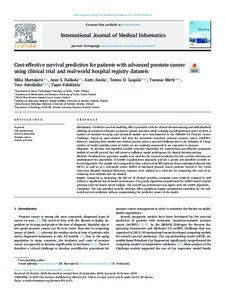Cost-effective survival prediction for patients with advanced prostate cancer using clinical trial and real-world hospital registry datasets
Tuomas Mirtti; Anni S. Halkola; Antti Airola; Tapio Pahikkala; Tero Aittokallio; Teemu D. Laajala; Mika Murtojärvi
https://urn.fi/URN:NBN:fi-fe2021042824823
Tiivistelmä
Introduction
Predictive survival modeling offers systematic tools for clinical decision-making and individualized tailoring of treatment strategies to improve patient outcomes while reducing overall healthcare costs. In 2015, a number of machine learning and statistical models were benchmarked in the DREAM 9.5 Prostate Cancer Challenge, based on open clinical trial data for metastatic castration resistant prostate cancer (mCRPC). However, applying these models into clinical practice poses a practical challenge due to the inclusion of a large number of model variables, some of which are not routinely monitored or are expensive to measure.
Objectives
To develop cost-specified variable selection algorithms for constructing cost-effective prognostic models of overall survival that still preserve sufficient model performance for clinical decision making.
Methods
Penalized Cox regression models were used for the survival prediction. For the variable selection, we implemented two algorithms: (i) LASSO regularization approach; and (ii) a greedy cost-specified variable selection algorithm. The models were compared in three cohorts of mCRPC patients from randomized clinical trials (RCT), as well as in a real-world cohort (RWC) of advanced prostate cancer patients treated at the Turku University Hospital. Hospital laboratory expenses were utilized as a reference for computing the costs of introducing new variables into the models.
Results
Compared to measuring the full set of clinical variables, economic costs could be reduced by half without a significant loss of model performance. The greedy algorithm outperformed the LASSO-based variable selection with the lowest tested budgets. The overall top performance was higher with the LASSO algorithm.
Conclusion
The cost-specified variable selection offers significant budget optimization capability for the real-world survival prediction without compromising the predictive power of the model.
Kokoelmat
- Rinnakkaistallenteet [19207]
